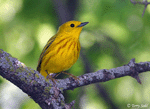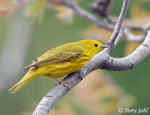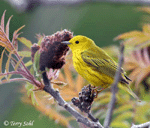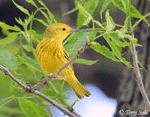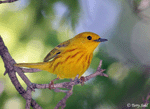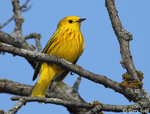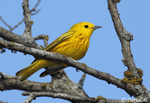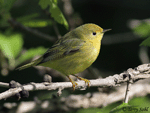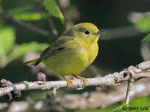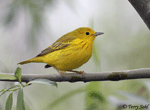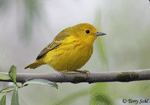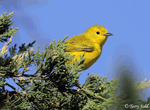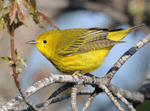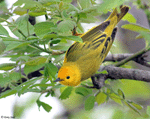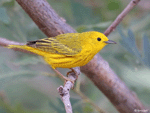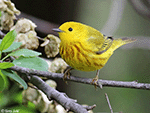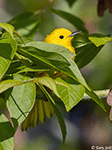| Length: 5 inches | Wingspan: 8 inches | Seasonality: Summer / Migrant |
| ID Keys: Male yellow body with darker-shaded wings, reddish streaking on underparts | ||
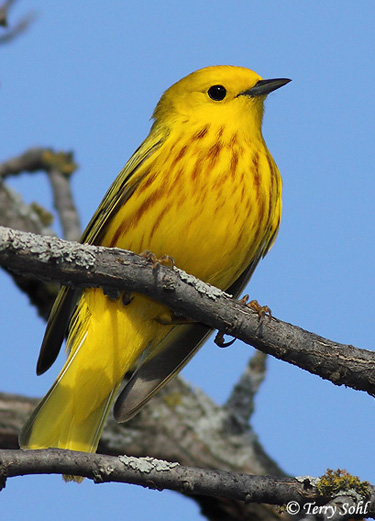 Yellow Warblers are one of the most widespread and common warblers in North America.
During the summer breeding season they can be found from north of the Arctic
Circle, all the way southward through Mexico The Yellow Warbler familiar to most in the United States appears as the bird to
the right, and represents the migratory form. Additional forms exist in other
parts of the Western Hemisphere (Caribbean, Mexico, Central America), and have much more chestnut or rufous color on
the head.
Yellow Warblers are one of the most widespread and common warblers in North America.
During the summer breeding season they can be found from north of the Arctic
Circle, all the way southward through Mexico The Yellow Warbler familiar to most in the United States appears as the bird to
the right, and represents the migratory form. Additional forms exist in other
parts of the Western Hemisphere (Caribbean, Mexico, Central America), and have much more chestnut or rufous color on
the head.
Habitat:
Woodlands, brush and thickets, orchards, residential areas. They are often found near water, including the brushy or otherwise vegetated margins around wetlands, lakes, ponds, and rivers.
Diet:
Mostly insects. Shows a decided preference for caterpillars. Occasionally will eat fruits and berries.
Behavior:
Uses a variety of foraging methodologies, including observing from a perch and flying out to capture flying insects (flycatching), climbing through vegetation and gleaning insects from vegetation foliage, or hovering and gleaning insects.
Nesting:
May through July. The nest is built in the fork of a small tree or bush by the female. It is a sturdy, multi-layer cup, built primarily of grasses, strips of bark, and weed stems. The inside is lined with softer materials such as downy plant fibers, hair, or feathers. She lays 3 to 6 eggs, and she alone incubates the eggs. The young hatch after about 12 days, with the young fledging about 10-12 days after hatching.Yellow Warblers are uniquely aware of the presence of Brown-headed Cowbird eggs in the nest. If cowbird eggs are detected, the female will often abandon all eggs in the nest, layering over the eggs and building a new nest floor on top of the old nest.
Song:
The song is often described as a melodic sweet-sweet-sweet-I'm-so-sweet. The call is a sweet cheep.
- Click here to hear the song of a male Yellow Warbler1
- Click here to hear the call of a Yellow Warbler2
- Click here to hear another song of a Yellow Warbler 3
Migration:
Yellow Warblers are neotropical migrants, wintering in Mexico, Central America, and South America. Non-migratory forms and other forms also exist in Central America, Mexico, and the Caribbean.
Interactive eBird map:
Click here to access an interactive eBird map of Yellow Warbler sightings
Similar Species:
A brilliantly colored bird, it's ironically the lack of coloring other than the brilliant yellow that distinguishes it from many of its warbler relatives. The plainer female Yellow Warbler is more likely to be confused with another species than the more brightly colored male.
- Wilson's Warbler - Male Wilson's Warblers are unlikely to be confused with Yellow Warblers, as they have an obvious black cap. Female Wilson's Warblers lack the black cap and look similar to a Yellow Warbler. However, even the females have a slightly darker cap that contrasts with a brighter yellow eyebrow, while a Yellow Warbler has more uniform head coloring.
- Orange-crowned Warbler - Orange-crowned Warblers are a very common migrant in South Dakota, and have a quite plain plumage pattern. Some brighter Orange-crowned Warblers could potentially be confused with a (female) Yellow Warbler, but they are less yellow overall, with more greenish tones.
- Prairie Warbler - With black facial stripes, black striping, and a chestnut patch on their back, male Prairie Warblers aren't likely to be confused with a Yellow Warbler. However, female Prairie Warblers are plainer, appearing to be yellow overall with faint striping below that could cause confusion with a Yellow Warbler. However, female Prairie Warblers have a grayish head (yellow on a Yellow Warbler) and lighter markings above and below the eye that give it the impression of wearing goggles.
- Cape May Warbler - Male Cape May Warblers are unlikely to be confused with a Yellow Warbler, but the plainer females could be. They're yellow overall with faint striping below, but the striping is black (more brown on a Yellow Warbler), and there's more contrasting markings on the face than on a Yellow Warbler.
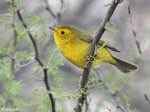 |
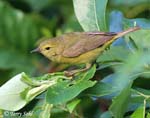 |
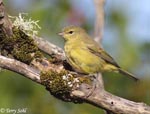 |
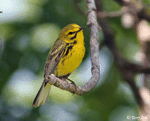 |
| Wilson's Warbler | Orange-crowned Warbler | Orange-crowned Warbler | Prairie Warbler |
South Dakota "Hotspot":
They aren't a difficult species to find in most of the state. They are found in a variety of habitats, but riparian areas or brushy growth near water are areas that often hold Yellow Warblers. This includes many of the state parks in the eastern part of South Dakota, where riparian vegetation grows along a water feature. The Sergeant Creek area in Newton Hills State Park, for example, always holds many Yellow Warblers during the spring and summer months.
Feeders:
Yellow Warblers aren't typically common feeder visitors, but they will on rare occasions attend feeders for nectar (sugar water), fruit, or suet. This is most likely to occur in the spring or fall when unusually cold temperatures reduce normal insect foods to a minimum.
Conservation Status:
Generally stable and widespread. Not as susceptible to habitat loss as many other species, due to its preference for woodland edges and second-growth forest. The IUCN considers the Yellow Warbler to be a species of "Least Concern".
Further Information:
Photo Information:
May 9th, 2011 - Big Sioux Recreation Area in Brandon, South Dakota -- Terry Sohl
Additional Photos:
Click on the image chips or text links below for additional, higher-resolution Yellow Warbler photos.
Audio File Credits:
- 1Sue Riffe. Recorded in Boulder County, Colorado on May 17th, 2020. Original recording and information available from xeno-canto.
- 2Manuel Grosselet. Recorded in Oaxaca, Mexico on January 10th, 2021. Original recording and information available from xeno-canto.
- 3Peter Boesman. Recorded near Seward, Alaska on June 4th, 2016. Original recording and information available from xeno-canto.
| Click on the map below for a higher-resolution view |
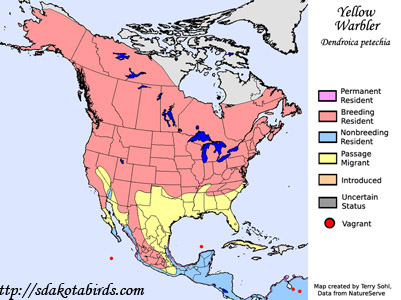 |
| South Dakota Status: Common migrant and summer resident throughout the state. |
Additional Yellow Warbler Photos
Click for a higher-resolution version of these photos
